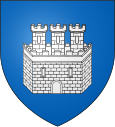Puycelsi
|
Puycelsi Puègcèlsi |
||
|---|---|---|

|
|
|
| region | Occitania | |
| Department | Camouflage | |
| Arrondissement | Albi | |
| Canton | Vignobles et Bastides | |
| Community association | Gaillac-Graulhet | |
| Coordinates | 44 ° 0 ′ N , 1 ° 43 ′ E | |
| height | 132-367 m | |
| surface | 39.2 km 2 | |
| Residents | 449 (January 1, 2017) | |
| Population density | 11 inhabitants / km 2 | |
| Post Code | 81140 | |
| INSEE code | 81217 | |
| Website | www.puycelsi.fr | |
 Puycelsi - the townscape |
||
Puycelsi (sometimes also written Puycelci ; Occitan : Puègcèlsi ) is a southern French municipality with 449 inhabitants (as of January 1, 2017) in the Tarn department in the Occitania region . The place is one of the ' Most Beautiful Villages in France '.
Toponym
The place name is derived from the Latin podium celsium ("flat hill of the Celts"), which is based on the Celtic celto dun .
location
Puycelsi is located on a hill that slopes steeply on three sides above the Vère valley, about 43 kilometers (driving distance) west of Albi or 24 kilometers north of the wine village of Gaillac . The former Bastide Castelnau-de-Montmiral (about twelve kilometers to the east) and the town of Bruniquel (about 13 kilometers north on the Aveyron River ) are also among the 'Most Beautiful Villages in France'.
Population development
| year | 1962 | 1968 | 1975 | 1982 | 1990 | 1999 | 2006 |
| Residents | 503 | 535 | 480 | 442 | 453 | 495 | 493 |
In the 19th century the place always had between 1,600 and 2,200 inhabitants. The phylloxera crisis in viticulture and the mechanization of agriculture resulted in job losses and, as a result, a steady decline in the population.
economy
Today the community lives primarily from agriculture and forestry as well as from handicrafts and small businesses. Since the 1960s, tourism has also played a role in the form of vacation rental.
history
In the 10th century, the place near a prehistoric place of worship was settled by Benedictine monks from Aurillac Abbey . In the time of the Albigensian Crusades (1209-1229) the place was besieged by the troops of Simon de Montforts ; after the Peace of Meaux (1229) the local castle was demolished. The city was besieged again in the Shepherd's Crusade of 1320 and also in the course of the Hundred Years War (1386).
Attractions
- The 800 meter long remains of the walls of the fortifications ( remparts ) have been recognized as Monument historique since 1927 . This also includes the city gate ( Porte de l'Irissou ), which has been shown separately as a monument historique since 1950 .
- There are several Renaissance houses made of precisely hewn natural stone from the 16th and 17th centuries in the immediate vicinity of quarry stone and half-timbered houses .
- The so-called Château des capitaines-gouverneurs dates from the 15th century.
- The parish church of Saint-Corneille , built in Gothic form in the 14th and 15th centuries , is dominated by a mighty west tower, the monumentality of which is softened by corner pilasters and cranked cornices . The interior of the church has a single nave with side chapels.
- The Rochus chapel ( Chapelle Saint-Roch ) directly adjoining the defensive wall has a small bell gable.
- A three-arched late medieval stone bridge ( Pont de Laval ) from the 14th / 15th centuries, formerly leading over the Vère, which was diverted in 1974 . Century has also been under protection as a Monument historique since 1991 .
- The Chapelle Saint-Julien-le-Vieux , located about two kilometers outside the village, has been recognized as a Monument historique since 2002 .
Web links
- Puycelsi - Photos + Info Most Beautiful Villages in France
- Festival de Puycelsi (French)
Individual evidence
- ^ Remparts, Puycelsi in the Base Mérimée of the French Ministry of Culture (French)
- ↑ Porte de l'Irissou, Puycelsi in the Base Mérimée of the French Ministry of Culture (French)
- ↑ Pont de Laval, Puycelsi in the Base Mérimée of the French Ministry of Culture (French)
- ↑ Chapelle Saint-Julien-le-Vieux, Puycelsi in the Base Mérimée of the French Ministry of Culture (French)




